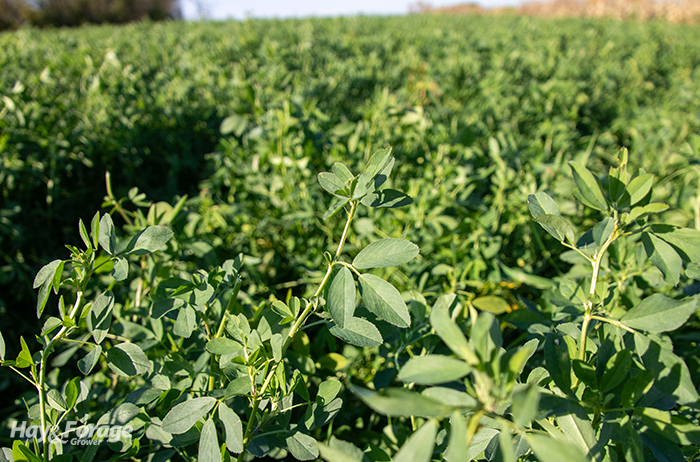
Though the calendar isn’t always a reliable resource to determine planting dates and harvest schedules, many farmers have an idea where their annual activities typically fall within those 12 pages. For example, a seasoned beef producer will know roughly what day their calving season will begin in mid-February; many haymakers aim to start first cutting by Memorial Day, weather permitting; and silage harvest is in full swing during late August and early September.
As we approach the last day of October, also known as Halloween, most choppers and balers will already be parked in the shed. Farmers and ranchers in regions where pastures go dormant will start to implement their winter feeding strategies, and farm shops will soon be buzzing with offseason equipment maintenance.
Halloween doesn’t make my list of observed holidays, but I have been reflecting on some of the more frightening forage-related topics and farm experiences that Hay & Forage Grower has covered over the years. This includes the horrifying case of hardware disease on this organic grazing dairy in Vermont where the farmers unknowingly chopped and fed cows a significant amount of metal after telephone wire was installed over their pastures and hayfields. Then there was the story about one forage crop that may have played a role in the series of events leading up to the Salem Witch Trials, which you can read more about here.
We have also used the term “Halloween hay” to refer to final cuttings of alfalfa that occur when regrowth potential is low, either right before or immediately after a killing frost. Even though forage quality may be the best of the season, the scary part is that late fall cuttings are low yielding — especially when the cutting height is raised to ensure ground cover and reinforce overwintering — and the small gain in fall yield is usually equal to the loss in spring yield as a result of a less vigorous stand. Learn more about why Halloween hay is often a losing proposition.
Perhaps the scariest story shared with me this summer was that of an Iowa beef grazier’s losing battle with bloat. After seven years of rotationally grazing cattle on a mixed stand of orchardgrass, tall fescue, smooth bromegrass, and a relatively high percentage of alfalfa, he had only lost a handful of animals to bloat. This year, however, more than 20 cattle in his 300-head herd fell victim to the bloat affliction — which he attributed to heavy alfalfa — prompting him to pull animals off of the perennial pasture and start grazing summer annuals early. He also vowed to eliminate alfalfa from his grazing rotation altogether.
Frothy bloat fears
Although the majority of this farmer’s bloat cases cropped up in late spring and early summer, others who plan to graze alfalfa yet this fall should beware of the elevated bloat risk associated with frosted forage as overnight temperatures creep toward freezing.
In most cases, bloat occurs when rumen gases get trapped in a stable foam produced by forage compounds like soluble leaf proteins, saponins, and hemicelluloses. Since alfalfa contains high levels of all of these compounds, it boasts a higher risk of frothy bloat, especially when animals graze vegetative alfalfa.
When plant cells freeze and rupture, those soluble proteins and carbohydrates become even more readily available to rumen microbes, and this amplifies frothy bloat incidence in cattle that are grazing frost-stricken alfalfa. Frothy bloat risk declines after plants have a chance to wilt, usually within five to seven days after a hard freeze; however, wilting doesn’t eliminate frothy bloat risk, and if temperatures climb after the cold spell, it can spike again.
Frothy bloat can be relatively mild, in which no intervention is necessary, and animals will recover on their own over time. In more severe cases, though, the rumen will distend enough to interfere with respiration and animals can suffocate to death.
Despite the looming threat of frothy bloat, some solutions to grazing alfalfa this fall include limiting access to straight alfalfa stands or mixed pastures containing a high percentage of alfalfa to a few hours per day. Feeding cattle hay prior to pasture turn out will also ensure they fill up on safer forages before consuming alfalfa.
Pastures that are at least 50% grass should provide sufficient effective fiber for cattle and create more of a scratch factor. This leads to more saliva production, slowing the rate of forage digestion and curbing foam production and rumen gas entrapment. Feeding animals anti-foaming compounds like ionophores or poloxalene, which can be found in molasses bloat blocks or topdressed on other supplements, may also reduce the incidence of frothy bloat.
Prussic acid poisoning
Other forages to caution after the first hard frost are those belonging to the sorghum family, such as forage sorghum, sorghum-sudangrass, and sudangrass. These species can cause prussic acid poisoning in grazing livestock when frosted plant cells rupture and dhurrin is converted into hydrogen cyanide. Symptoms of prussic acid poisoning include muscle twitching, staggering, and in severe cases, death, which can occur within minutes.
Similar to frothy bloat risk in alfalfa, the potential for prussic acid poisoning drops to safe levels about one week after a hard freeze; however, if another frost event occurs during that week, the waiting period must start over. In the meantime, forage regrowth may emerge, which contains higher concentrations of dhurrin and poses a greater risk of prussic acid poisoning for grazing animals.
In general, previous management recommendations have suggested that prussic acid concentrations would decline in dry hay, but new research proves this to be untrue. Harvesting sorghum species as silage or baleage is a better alternative as the fermentation process has been shown to reduce prussic acid concentrations by up to 50%.

